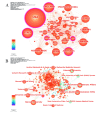Development Trends and Prospects of Technology-Based Solutions for Health Challenges in Aging Over the Past 25 Years: Bibliometric Analysis
- PMID: 39238480
- PMCID: PMC11452759
- DOI: 10.2196/63367
Development Trends and Prospects of Technology-Based Solutions for Health Challenges in Aging Over the Past 25 Years: Bibliometric Analysis
Abstract
Background: As the global population ages, we witness a broad scientific and technological revolution tailored to meet the health challenges of older adults. Over the past 25 years, technological innovations, ranging from advanced medical devices to user-friendly mobile apps, are transforming the way we address these challenges, offering new avenues to enhance the quality of life and well-being of the aging demographic.
Objective: This study aimed to systematically review the development trends in technology for managing and caring for the health of older adults over the past 25 years and to project future development prospects.
Methods: We conducted a comprehensive bibliometric analysis of literatures related to technology-based solutions for health challenges in aging, published up to March 18, 2024. The search was performed using the Web of Science Core Collection, covering a span from 1999 to 2024. Our search strategy was designed to capture a broad spectrum of terms associated with aging, health challenges specific to older adults, and technological interventions.
Results: A total of 1133 publications were found in the Web of Science Core Collection. The publication trend over these 25 years showed a gradual but fluctuating increase. The United States was the most productive country and participated in international collaboration most frequently. The predominant keywords identified through this analysis included "dementia," "telemedicine," "older-adults," "telehealth," and "care." The keywords with citation bursts included "telemedicine" and "digital health."
Conclusions: The scientific and technological revolution has significantly improved older adult health management, particularly in chronic disease monitoring, mobility, and social connectivity. The momentum for innovation continues to build, with future research likely to focus on predictive analytics and personalized health care solutions, further enhancing older adults' independence and quality of life.
Keywords: AI; AI-driven; CiteSpace; VOSviewer; ageing; aging; aging health; artificial intelligence; bibliometrics; challenges; elder; elderly; geriatric; geriatrics; gerontology; health challenges; health management; innovation; innovations; monitoring; older adult; older adults; older people; older person; remote; remote care; remote monitoring; surveillance; tech-based; technological innovations; technology; technology-based; telemedicine; trends; visualization.
©Lu Liu, Xiu-Ling Wang, Nuo Cheng, Fu-Min Yu, Hui-Jun Li, Yang Mu, Yonghui Yuan, Jia-Xin Dong, Yu-Dan Wu, Da-Xin Gong, Shuang Wang, Guang-Wei Zhang. Originally published in the Journal of Medical Internet Research (https://www.jmir.org), 20.09.2024.
Conflict of interest statement
Conflicts of Interest: None declared.
Figures



Similar articles
-
Research Trends in the Application of Artificial Intelligence in Oncology: A Bibliometric and Network Visualization Study.Front Biosci (Landmark Ed). 2022 Aug 31;27(9):254. doi: 10.31083/j.fbl2709254. Front Biosci (Landmark Ed). 2022. PMID: 36224012
-
Artificial Intelligence in Telemedicine: A Global Perspective Visualization Analysis.Telemed J E Health. 2024 Jun;30(7):e1909-e1922. doi: 10.1089/tmj.2023.0704. Epub 2024 Mar 1. Telemed J E Health. 2024. PMID: 38436235
-
Global scientific research on social participation of older people from 2000 to 2019: A bibliometric analysis.Int J Older People Nurs. 2021 Jan;16(1):e12349. doi: 10.1111/opn.12349. Epub 2020 Sep 20. Int J Older People Nurs. 2021. PMID: 32951349 Free PMC article.
-
Advances in applying somatosensory interaction technology in geriatric care: A bibliometric analysis.Int J Nurs Sci. 2024 Oct 12;11(5):571-577. doi: 10.1016/j.ijnss.2024.10.009. eCollection 2024 Nov. Int J Nurs Sci. 2024. PMID: 39698138 Free PMC article. Review.
-
Use of Digital Health Technologies for Dementia Care: Bibliometric Analysis and Report.JMIR Ment Health. 2025 Feb 10;12:e64445. doi: 10.2196/64445. JMIR Ment Health. 2025. PMID: 39928936 Free PMC article.
Cited by
-
Research trends in the application of artificial intelligence in nursing of chronic disease: a bibliometric and network visualization study.Front Digit Health. 2025 Jun 18;7:1608266. doi: 10.3389/fdgth.2025.1608266. eCollection 2025. Front Digit Health. 2025. PMID: 40613079 Free PMC article.
References
-
- Gu D, Andreev K, Dupre ME. Major trends in population growth around the world. China CDC Wkly. 2021 Jul 09;3(28):604–613. doi: 10.46234/ccdcw2021.160. https://europepmc.org/abstract/MED/34594946 ccdcw-3-28-604 - DOI - PMC - PubMed
-
- Zhou B, Deng Q, Zhou S, Zhuo D. Health care in future community: innovatively discover and respond to the needs of today's seniors. Front Public Health. 2023 Dec 12;11:1302493. doi: 10.3389/fpubh.2023.1302493. https://europepmc.org/abstract/MED/38152669 - DOI - PMC - PubMed
-
- Wang Z, Yang Z, Dong T. A review of wearable technologies for elderly care that can accurately track indoor position, recognize physical activities and monitor vital signs in real time. Sensors (Basel) 2017 Feb 10;17(2):341. doi: 10.3390/s17020341. https://www.mdpi.com/resolver?pii=s17020341 s17020341 - DOI - PMC - PubMed
-
- Ambagtsheer R, Shafiabady N, Dent E, Seiboth C, Beilby J. The application of artificial intelligence (AI) techniques to identify frailty within a residential aged care administrative data set. Int J Med Inform. 2020 Apr;136:104094. doi: 10.1016/j.ijmedinf.2020.104094.S1386-5056(19)31364-4 - DOI - PubMed
MeSH terms
LinkOut - more resources
Full Text Sources
Medical
Research Materials
Miscellaneous

